- Quiz will start as soon as you click the ‘Start Quiz‘ button below.
- Question will come one by one click on next for next question
- There are 30 questions in this quiz, you will get 30 Minutes to attempt.
- 2 Marks is determined for the correct answer for each question. There is no negative marking for incorrect answer.
- After the quiz is over, in order to know your rank in the Ranking List / Leader-board below, you should enter your name and email address, otherwise you will be deprived of it.
- After completing click on finish Quiz
- To see correct answers click on view Question
- जैसे ही आप नीचे दिए गए ‘स्टार्ट क्विज़’ बटन पर क्लिक करेंगे, क्विज़ शुरू हो जाएगा।
प्रश्न अगले प्रश्न के लिए अगले एक क्लिक पर आएगा
इस क्विज में 30 प्रश्न हैं, आपको प्रयास करने के लिए 30 मिनट मिलेंगे।
प्रत्येक प्रश्न के सही उत्तर के लिए 2 अंक निर्धारित किए गए हैं। गलत उत्तर के लिए कोई नकारात्मक अंकन नहीं है।
प्रश्नोत्तरी समाप्त होने के बाद, नीचे दी गई रैंकिंग सूची / लीडर-बोर्ड में अपनी रैंक जानने के लिए, आपको अपना नाम और ईमेल पता दर्ज करना चाहिए, अन्यथा आप इससे वंचित रह जाएंगे।
फिनिश क्विज़ पर क्लिक करने के बाद
सही उत्तर देखने के लिए प्रश्न पर क्लिक करें
Paper 2 CS Discrete Structures and Optimization Part 3
Quiz-summary
0 of 30 questions completed
Questions:
- 1
- 2
- 3
- 4
- 5
- 6
- 7
- 8
- 9
- 10
- 11
- 12
- 13
- 14
- 15
- 16
- 17
- 18
- 19
- 20
- 21
- 22
- 23
- 24
- 25
- 26
- 27
- 28
- 29
- 30
Information
Paper 1 Quiz helps u to Excel in NET JRF
Paper 1 All questions 2 Marks each
- Navdeep Kaur
- All the Best
You have already completed the quiz before. Hence you can not start it again.
Quiz is loading…
You must sign in or sign up to start the quiz.
You have to finish following quiz, to start this quiz:
Results
0 of 30 questions answered correctly
Your time:
Time has elapsed
You have reached 0 of 0 points, (0)
| Average score |
|
| Your score |
|
Categories
- Not categorized 0%
-
Average marks Improve next time All the Best
-
Nice Keep it up, Stay Blessed
-
Awesome Great Marks, Keep doing
| Pos. | Name | Entered on | Points | Result |
|---|---|---|---|---|
| Table is loading | ||||
| No data available | ||||
- 1
- 2
- 3
- 4
- 5
- 6
- 7
- 8
- 9
- 10
- 11
- 12
- 13
- 14
- 15
- 16
- 17
- 18
- 19
- 20
- 21
- 22
- 23
- 24
- 25
- 26
- 27
- 28
- 29
- 30
- Answered
- Review
-
Question 1 of 30
1. Question
2 points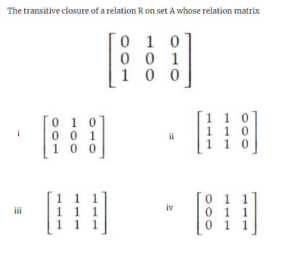 Correct
Correct
The transitive closure of R is obtained by repeatedly adding (a,c) to R for each (a,b) ∈ R and (b,c) ∈ R.
Incorrect
The transitive closure of R is obtained by repeatedly adding (a,c) to R for each (a,b) ∈ R and (b,c) ∈ R.
-
Question 2 of 30
2. Question
1 pointsLet A and B be two arbitrary events, then :
Correct
“Option-A is happens when A and B are independent.
Option-B is happens when A and B are mutually exclusive. P(A∪B) ≤ P(A) + P(B) is true because P(A∪B) = P(A) + P(B) – P(A∩B) “Incorrect
“Option-A is happens when A and B are independent.
Option-B is happens when A and B are mutually exclusive. P(A∪B) ≤ P(A) + P(B) is true because P(A∪B) = P(A) + P(B) – P(A∩B) “ -
Question 3 of 30
3. Question
2 pointsIf the proposition ¬ P → Q is true, then the truth value of the proportion ¬ PV (P → Q) is:
Correct
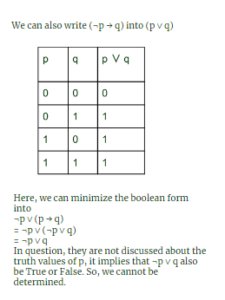 Incorrect
Incorrect

-
Question 4 of 30
4. Question
2 pointsT is a graph with n vertices. T is connected and has exactly n-1 edges, then :
Correct
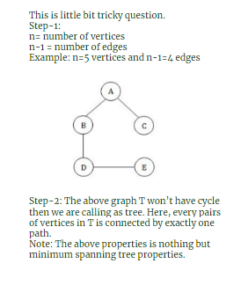 Incorrect
Incorrect

-
Question 5 of 30
5. Question
2 points“The following lists are the degrees of all the vertices of a graph :
(i) 1, 2, 3, 4, 5
(ii) 3, 4, 5, 6, 7
(iii) 1, 4, 5, 8, 6
(iv) 3, 4, 5, 6
then “Correct
“Every graph is following basic 2 properties:
1. Sum of degrees of the vertices of a graph should be even.
2. Sum of degrees of the vertices of a graph is equal to twice the number of edges.
Statement-(i) is violating property-1.
= 1+2+3+4+5
= 15 is odd number.
Statement-(ii) is violating property-1.
= 3+4+5+6+7
= 25 is odd number.
Statement-(iii) is violating property-1.
= 1+4+5+8+6
= 24 is even number
Statement-(iv) is violating property-1
= 3+4+5+6
= 18 is even number “Incorrect
“Every graph is following basic 2 properties:
1. Sum of degrees of the vertices of a graph should be even.
2. Sum of degrees of the vertices of a graph is equal to twice the number of edges.
Statement-(i) is violating property-1.
= 1+2+3+4+5
= 15 is odd number.
Statement-(ii) is violating property-1.
= 3+4+5+6+7
= 25 is odd number.
Statement-(iii) is violating property-1.
= 1+4+5+8+6
= 24 is even number
Statement-(iv) is violating property-1
= 3+4+5+6
= 18 is even number “ -
Question 6 of 30
6. Question
2 pointsIf f(x) = x+1 and g(x)=x+3 then f0 f0 f0 f is :
Correct
“Given data,
f(x)=x+1
g(x)=x+3
Constraint is f0 f0 f0 f
Step-1: We can write into fo fo fo f is f(f(f(x+1)))
We can write into f(f(x+2)) and f(x+3).
Step-2: Above constraint is equal to “”x+4″” because f(x+3)+1
Step-3: We can also write into fog(x)=x+4 and gof(x)=x+4.
So, g+1 is appropriate answer. “Incorrect
“Given data,
f(x)=x+1
g(x)=x+3
Constraint is f0 f0 f0 f
Step-1: We can write into fo fo fo f is f(f(f(x+1)))
We can write into f(f(x+2)) and f(x+3).
Step-2: Above constraint is equal to “”x+4″” because f(x+3)+1
Step-3: We can also write into fog(x)=x+4 and gof(x)=x+4.
So, g+1 is appropriate answer. “ -
Question 7 of 30
7. Question
2 points“A v A=A is called :
Correct
List of theorems!
Incorrect
List of theorems!
-
Question 8 of 30
8. Question
2 points“Consider a proposition given as :
“ x ≥ 6, if x 2 ≥ 5 and its proof as:
If x ≥ 6, then x 2 = x.x ≥ 6.6 = 36 ≥ 25
Which of the following is correct w.r.to the given proposition and its proof?
(a)The proof shows the converse of what is to be proved.
(b)The proof starts by assuming what is to be shown.
(c)The proof is correct and there is nothing wrong. “Correct
The proof which is described in the question is wrong because for a given “x” value , x 2 >=5 but in the proof they mentioned 36>=25 which is wrong.
Incorrect
The proof which is described in the question is wrong because for a given “x” value , x 2 >=5 but in the proof they mentioned 36>=25 which is wrong.
-
Question 9 of 30
9. Question
2 points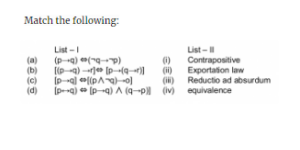 Correct
Correct
“→ In logic, contraposition is an inference that says that a conditional statement is logically equivalent to its contrapositive. The contrapositive of the statement has its antecedent and consequent inverted and flipped: the contrapositive of P → Q is thus as ~Q → ~P.
→ The equivalence relation translates verbally into “”if and only if”” and is symbolized by a double-lined, double arrow pointing to the left and right (↔). If A and B represent statements, then A ↔ B means “”A if and only if B.””
→ The exportation rule is a rule in logic which states that “”if (P and Q), then R”” is equivalent to “”if P then (if Q then R)””.
→ The exportation rule may be formally stated as: (P ∧ Q) → R is equivalent to P → (Q →R)
→ A mode of argumentation or a form of argument in which a proposition is disproven by following its implications logically to an absurd conclusion. Arguments that use universals such as, “always”, “never”, “everyone”, “nobody”, etc., are prone to being reduced to absurd conclusions. The fallacy is in the argument that could be reduced to absurdity — so in essence, reductio ad absurdum is a technique to expose the fallacy. “Incorrect
“→ In logic, contraposition is an inference that says that a conditional statement is logically equivalent to its contrapositive. The contrapositive of the statement has its antecedent and consequent inverted and flipped: the contrapositive of P → Q is thus as ~Q → ~P.
→ The equivalence relation translates verbally into “”if and only if”” and is symbolized by a double-lined, double arrow pointing to the left and right (↔). If A and B represent statements, then A ↔ B means “”A if and only if B.””
→ The exportation rule is a rule in logic which states that “”if (P and Q), then R”” is equivalent to “”if P then (if Q then R)””.
→ The exportation rule may be formally stated as: (P ∧ Q) → R is equivalent to P → (Q →R)
→ A mode of argumentation or a form of argument in which a proposition is disproven by following its implications logically to an absurd conclusion. Arguments that use universals such as, “always”, “never”, “everyone”, “nobody”, etc., are prone to being reduced to absurd conclusions. The fallacy is in the argument that could be reduced to absurdity — so in essence, reductio ad absurdum is a technique to expose the fallacy. “ -
Question 10 of 30
10. Question
2 points““If my computations are correct and I pay the electric bill, then I will run out of money. If I don’t pay the electric bill, the power will be turned off. Therefore, if I don’t run out of money and the power is still on, then my computations are incorrect.”
Convert this argument into logical notations using the variables c, b, r, p for propositions of computations, electric bills, out of money and the power respectively. (Where ¬ means NOT)”Correct
“We can represent ,
“c” for my computations are correct
“b” for I pay the electric bill.
“r” for I will run out of money
“p” for the power is on.
(c Λ b) means my computations are correct and I pay the electric bill.
(¬r Λ p) means I don’t run out of money and the power is still on.
According to the statement , the option -(A) is correct. “Incorrect
“We can represent ,
“c” for my computations are correct
“b” for I pay the electric bill.
“r” for I will run out of money
“p” for the power is on.
(c Λ b) means my computations are correct and I pay the electric bill.
(¬r Λ p) means I don’t run out of money and the power is still on.
According to the statement , the option -(A) is correct. “ -
Question 11 of 30
11. Question
2 points“Consider a Hamiltonian Graph (G) with no loops and parallel edges. Which of the following is true with respect to this Graph (G) ?
(a) deg (v) ≥ n / 2 for each vertex of G
(b) |E(G)| ≥ 1 / 2 (n – 1) (n – 2) + 2 edges
(c) deg (v) + deg (w) ≥ n for every n and v not connected by an edge. “Correct
“→ According to Dirac’s theorem on Hamiltonian cycles, the statement that an n-vertex graph in which each vertex has degree at least n/2 must have a Hamiltonian cycle.
→ According to ore’s theorem,Let G be a (finite and simple) graph with n ≥ 3 vertices. We denote by deg v the degree of a vertex v in G, i.e. the number of incident edges in G to v. Then, Ore’s theorem states that if deg v + deg w ≥ n for every pair of distinct non adjacent vertices v and w of G, then G is Hamiltonian.
→ A complete graph G of n vertices has n(n−1)/2 edges and a Hamiltonian cycle in G contains n edges. Therefore the number of edge-disjoint Hamiltonian cycles in G cannot exceed (n − 1)/2. When n is odd, we show there are (n − 1)/2 edge-disjoint Hamiltonian cycles.
So the statement(b) is false and statement a and c are true. “Incorrect
“→ According to Dirac’s theorem on Hamiltonian cycles, the statement that an n-vertex graph in which each vertex has degree at least n/2 must have a Hamiltonian cycle.
→ According to ore’s theorem,Let G be a (finite and simple) graph with n ≥ 3 vertices. We denote by deg v the degree of a vertex v in G, i.e. the number of incident edges in G to v. Then, Ore’s theorem states that if deg v + deg w ≥ n for every pair of distinct non adjacent vertices v and w of G, then G is Hamiltonian.
→ A complete graph G of n vertices has n(n−1)/2 edges and a Hamiltonian cycle in G contains n edges. Therefore the number of edge-disjoint Hamiltonian cycles in G cannot exceed (n − 1)/2. When n is odd, we show there are (n − 1)/2 edge-disjoint Hamiltonian cycles.
So the statement(b) is false and statement a and c are true. “ -
Question 12 of 30
12. Question
2 pointsIn how many ways can 15 indistinguishable fish be placed into 5 different ponds, so that each pond contains at least one fish ?
Correct
“→ We know that if we have “n” identical items which will be distributed in “r” distinct groups where each must get at least one then the number of way is C(n−1,r−1)
→ From the given question, n=15, r=5 We need to calculate C(14,4) and it’s value is 1001. “Incorrect
“→ We know that if we have “n” identical items which will be distributed in “r” distinct groups where each must get at least one then the number of way is C(n−1,r−1)
→ From the given question, n=15, r=5 We need to calculate C(14,4) and it’s value is 1001. “ -
Question 13 of 30
13. Question
2 pointsConsider an experiment of tossing two fair dice, one black and one red. What is the probability that the number on the black die divides the number on red die?
Correct
“→ From the given data, there are two dice and each dice the possible ways are 6. So total possible ways are 6*6=36 ways.
→ The possible ways are 1,2,3,4,5,6
→ The possible ways of one number divides another number are (1,1) (1,2), (1,3), (1,4), (1,5), (1,6), (2,2), (2,4), (2,6), (3,3), (3,6), (4,4), (5,5) and (6,6).
→ The probability is the number of outcomes / total outcomes = 14/36 “Incorrect
“→ From the given data, there are two dice and each dice the possible ways are 6. So total possible ways are 6*6=36 ways.
→ The possible ways are 1,2,3,4,5,6
→ The possible ways of one number divides another number are (1,1) (1,2), (1,3), (1,4), (1,5), (1,6), (2,2), (2,4), (2,6), (3,3), (3,6), (4,4), (5,5) and (6,6).
→ The probability is the number of outcomes / total outcomes = 14/36 “ -
Question 14 of 30
14. Question
2 pointsHow many strings of 5 digits have the property that the sum of their digits is 7?
Correct
“→ From the given question, there should be string with 5 digits and sum of that digits should be 7
→ There is no specification about positive,negative digits and also repetition of digits.
→ We are assuming the positive digits which is greater than or equal to 0.
→ The starting digit of the string should not be zero. We will also consider the repetition of digits.
→ Example of such strings are 70000,61000,60100,60010..,
→ The possible number of strings are C((n+r-1),(r-1))
→ From the given data n=7,r=5 then We have to fine C(11,4) which is equal to 330 “Incorrect
“→ From the given question, there should be string with 5 digits and sum of that digits should be 7
→ There is no specification about positive,negative digits and also repetition of digits.
→ We are assuming the positive digits which is greater than or equal to 0.
→ The starting digit of the string should not be zero. We will also consider the repetition of digits.
→ Example of such strings are 70000,61000,60100,60010..,
→ The possible number of strings are C((n+r-1),(r-1))
→ From the given data n=7,r=5 then We have to fine C(11,4) which is equal to 330 “ -
Question 15 of 30
15. Question
2 pointsHow many solutions are there for the equation x + y + z + u = 29 subject to the constraints that x ≥ 1, y ≥ 2, z ≥ 3 and u ≥ 0?
Correct
“Given data,
— The equation x+y+z+u = 29
— Constraints are x ≥ 1, y ≥ 2, z ≥ 3 and u ≥ 0
— Possible solutions?
Step-1: Combine all constraints (1+2+3+0) =6
Step-2: Subtract all constraints values with total equation number 29-6 =23.
Possibility to get repetition of a numbers of x,y and z but no chance for ‘u’ because its value is 0.
Step-3: So, Subtract repeated values into total equation value
= 29-3
= 26
Step-4: Possible solutions= 26 C 23
= 2600 “Incorrect
“Given data,
— The equation x+y+z+u = 29
— Constraints are x ≥ 1, y ≥ 2, z ≥ 3 and u ≥ 0
— Possible solutions?
Step-1: Combine all constraints (1+2+3+0) =6
Step-2: Subtract all constraints values with total equation number 29-6 =23.
Possibility to get repetition of a numbers of x,y and z but no chance for ‘u’ because its value is 0.
Step-3: So, Subtract repeated values into total equation value
= 29-3
= 26
Step-4: Possible solutions= 26 C 23
= 2600 “ -
Question 16 of 30
16. Question
2 points“Which of the following property/ies a Group G must hold, in order to be an Abelian group?
(a)The distributive property
(b)The commutative property
(c)The symmetric property “Correct
“An abelian group is a set, A, together with an operation • that combines any two elements a and b to form another element denoted a • b. The symbol • is a general placeholder for a concretely given operation. To qualify as an abelian group, the set and operation, (A, •), must satisfy five requirements known as the abelian group axioms:
Closure: For all a, b in A, the result of the operation a • b is also in A.
Associativity: For all a, b and c in A, the equation (a • b) • c = a • (b • c) holds.
Identity element: There exists an element e in A, such that for all elements a in A, the equation e • a = a • e = a holds.
Inverse element: For each a in A, there exists an element b in A such that a • b = b • a = e, where e is the identity element.
Commutativity: For all a, b in A, a • b = b • a.
A group in which the group operation is not commutative is called a “”non-abelian group”” or “”non-commutative group””. “Incorrect
“An abelian group is a set, A, together with an operation • that combines any two elements a and b to form another element denoted a • b. The symbol • is a general placeholder for a concretely given operation. To qualify as an abelian group, the set and operation, (A, •), must satisfy five requirements known as the abelian group axioms:
Closure: For all a, b in A, the result of the operation a • b is also in A.
Associativity: For all a, b and c in A, the equation (a • b) • c = a • (b • c) holds.
Identity element: There exists an element e in A, such that for all elements a in A, the equation e • a = a • e = a holds.
Inverse element: For each a in A, there exists an element b in A such that a • b = b • a = e, where e is the identity element.
Commutativity: For all a, b in A, a • b = b • a.
A group in which the group operation is not commutative is called a “”non-abelian group”” or “”non-commutative group””. “ -
Question 17 of 30
17. Question
2 points“Consider the compound propositions given below as:
(a)p ∨ ~(p ∧ q)
(b)(p ∧ ~q) ∨ ~(p ∧ q)
(c)p ∧ (q ∨ r)
Which of the above propositions are tautologies? “Correct
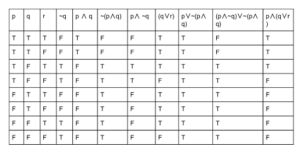 Incorrect
Incorrect

-
Question 18 of 30
18. Question
2 points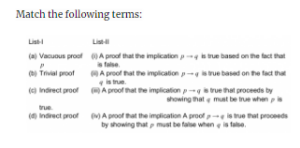 Correct
Correct
“→ Vacuous proof is a proof that the implication p → q is true based on the fact that p is false.
→ Trivial proof is a proof that the implication p → q is true based on the fact that q is true.
→ Direct proof is a proof that the implication p → q is true that proceeds by showing that q must be true when p is true.
→ Indirect proof is a proof that the implication p → q is true that proceeds by showing that p must be false when q is false. “Incorrect
“→ Vacuous proof is a proof that the implication p → q is true based on the fact that p is false.
→ Trivial proof is a proof that the implication p → q is true based on the fact that q is true.
→ Direct proof is a proof that the implication p → q is true that proceeds by showing that q must be true when p is true.
→ Indirect proof is a proof that the implication p → q is true that proceeds by showing that p must be false when q is false. “ -
Question 19 of 30
19. Question
2 points“Which of the following arguments are not valid ?
(a) “If Gora gets the job and works hard, then he will be promoted. If Gora gets promotion, then he will be happy. He will not be happy, therefore, either he will not get the job or he will not work hard”.
(b) “Either Puneet is not guilty or Pankaj is telling the truth. Pankaj is not telling the truth, therefore, Puneet is not guilty”.
(c) If n is a real number such that n >1, then n 2 >1. Suppose that n 2 >1, then n >1. “Correct
Validity using inferences
Incorrect
Validity using inferences
-
Question 20 of 30
20. Question
2 points Correct
Correct
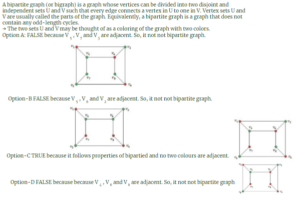 Incorrect
Incorrect

-
Question 21 of 30
21. Question
2 points“Which of the following is/are not true?
(a) The set of negative integers is countable.
(b) The set of integers that are multiples of 7 is countable.
(c)The set of even integers is countable.
(d)The set of real numbers between 0 and 1⁄2 is countable. “Correct
“(a)TRUE: The set of negative integers is countable.
Suppose negative integers set size is 10.
Ex: -1, -2, -3,…..,-10 is countable
(b)TRUE: The set of integers that are multiples of 7 is countable.
Suppose set of integers size is 10.
Ex: 1*7, 2*7, 3*7, …..,10*7 is countable
(c)TRUE: The set of even integers is countable.
Suppose set of even integers size is 10.
Ex: 2,4,6,8,10,….,20
(d) FALSE: The set of real numbers between 0 and 1⁄2 is countable. We can’t count real numbers.
Ex: 0.1, 0.2, 0.3, …..,0.∞ “Incorrect
“(a)TRUE: The set of negative integers is countable.
Suppose negative integers set size is 10.
Ex: -1, -2, -3,…..,-10 is countable
(b)TRUE: The set of integers that are multiples of 7 is countable.
Suppose set of integers size is 10.
Ex: 1*7, 2*7, 3*7, …..,10*7 is countable
(c)TRUE: The set of even integers is countable.
Suppose set of even integers size is 10.
Ex: 2,4,6,8,10,….,20
(d) FALSE: The set of real numbers between 0 and 1⁄2 is countable. We can’t count real numbers.
Ex: 0.1, 0.2, 0.3, …..,0.∞ “ -
Question 22 of 30
22. Question
2 points“Which of the following statement(s) is/are false ?
(a) A connected multigraph has an Euler Circuit if and only if each of its vertices has even degree.
(b) A connected multigraph has an Euler Path but not an Euler Circuit if and only if it has exactly two vertices of odd degree.
(c) A complete graph (K n ) has a Hamilton Circuit whenever n ≥ 3.
(d) A cycle over six vertices (C 6 ) is not a bipartite graph but a complete graph over 3 vertices is bipartite. “Correct
“(a)TRUE: A connected multigraph has an Euler Circuit if and only if each of its vertices has even degree.
(b)TRUE: A connected multigraph has an Euler Path but not an Euler Circuit if and only if it has exactly two vertices of odd degree.
(c)TRUE: A complete graph (K n ) has a Hamilton Circuit whenever n ≥ 3. (d) FALSE: A cycle over six vertices (C 6 ) is not a bipartite graph but a complete graph over 3 vertices is bipartite. “Incorrect
“(a)TRUE: A connected multigraph has an Euler Circuit if and only if each of its vertices has even degree.
(b)TRUE: A connected multigraph has an Euler Path but not an Euler Circuit if and only if it has exactly two vertices of odd degree.
(c)TRUE: A complete graph (K n ) has a Hamilton Circuit whenever n ≥ 3. (d) FALSE: A cycle over six vertices (C 6 ) is not a bipartite graph but a complete graph over 3 vertices is bipartite. “ -
Question 23 of 30
23. Question
2 points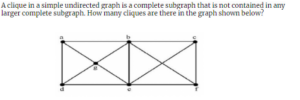 Correct
Correct
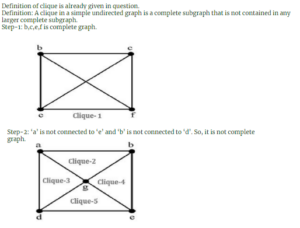 Incorrect
Incorrect

-
Question 24 of 30
24. Question
2 pointsThere are three cards in a box. Both sides of one card are black, both sides of one card are red, and the third card has one black side and one red side. We pick a card at random and observe only one side. What is the probability that the opposite side is the same colour as the one side we observed?
Correct
“Given data,
— 3 cards in a box
— 1 st card: Both sides of one card is black. The card having 2 sides. We can write it as BB.
— 2 nd card: Both sides of one card is red. The card having 2 sides. We can write it as RR.
— 3rd card: one black side and one red side. We can write it as BR.
Step-1: The probability that the opposite side is the same colour as the one side we observed is 2⁄3 because total number of cards are 3 “Incorrect
“Given data,
— 3 cards in a box
— 1 st card: Both sides of one card is black. The card having 2 sides. We can write it as BB.
— 2 nd card: Both sides of one card is red. The card having 2 sides. We can write it as RR.
— 3rd card: one black side and one red side. We can write it as BR.
Step-1: The probability that the opposite side is the same colour as the one side we observed is 2⁄3 because total number of cards are 3 “ -
Question 25 of 30
25. Question
2 pointsSuppose that R 1 and R 2 are reflexive relations on a set A. Which of the following statements is correct ?
Correct
“A binary relation R over a set X is reflexive if every element of X is related to itself. Formally, this may be written ∀ x ∈X : xRx.
Ex: Let set A={0,1}
R 1 ={(0,0),(1,1)} all diagonal elements we are considering for reflexive relation.
R 2 ={(0,0),(1,1)} all diagonal elements we are considering for reflexive relation.
R 1 ∩ R 2 must have {(0,0),(1,1)} is reflexive.
R 1 ∪ R 2 must have {(0,0),(1,1)} is reflexive. “Incorrect
“A binary relation R over a set X is reflexive if every element of X is related to itself. Formally, this may be written ∀ x ∈X : xRx.
Ex: Let set A={0,1}
R 1 ={(0,0),(1,1)} all diagonal elements we are considering for reflexive relation.
R 2 ={(0,0),(1,1)} all diagonal elements we are considering for reflexive relation.
R 1 ∩ R 2 must have {(0,0),(1,1)} is reflexive.
R 1 ∪ R 2 must have {(0,0),(1,1)} is reflexive. “ -
Question 26 of 30
26. Question
2 pointsThe number of different spanning trees in complete graph, K 4 and bipartite graph, K 2,2 have ______ and _______ respectively.
Correct
“Step-1: Given complete graph K 4 .To find total number of spanning tree in complete graph using standard formula is n (n-2) Here, n=4
=n (n-2)
= 4 2
=16
Step-2: Given Bipartite graph K 2,2 . To find number of spanning tree in a bipartite graph K m,n having standard formula is m (n-1) * n (m-1) .
m=2 and n=2
= 2 (2-1) * 2 (2-1)
= 2 * 2
= 4 “Incorrect
“Step-1: Given complete graph K 4 .To find total number of spanning tree in complete graph using standard formula is n (n-2) Here, n=4
=n (n-2)
= 4 2
=16
Step-2: Given Bipartite graph K 2,2 . To find number of spanning tree in a bipartite graph K m,n having standard formula is m (n-1) * n (m-1) .
m=2 and n=2
= 2 (2-1) * 2 (2-1)
= 2 * 2
= 4 “ -
Question 27 of 30
27. Question
2 pointsHow many different equivalence relations with exactly three different equivalence classes are there on a set with five elements?
Correct
“Step-1: Given number of equivalence classes with 5 elements with three elements in each class will be 1,2,2 (or) 2,1,2 (or) 2,2,1 and 3,1,1.
Step-2: The number of combinations for three equivalence classes are
2,2,1 chosen in ( 5 C 2 * 3 C 2 * 1 C 1 )/2! = 15
3,1,1 chosen in( 5 C 2 * 3 C 2 * 1 C 1 )/2! = 10
Step-3: Total differential classes are 15+10
=25. “Incorrect
“Step-1: Given number of equivalence classes with 5 elements with three elements in each class will be 1,2,2 (or) 2,1,2 (or) 2,2,1 and 3,1,1.
Step-2: The number of combinations for three equivalence classes are
2,2,1 chosen in ( 5 C 2 * 3 C 2 * 1 C 1 )/2! = 15
3,1,1 chosen in( 5 C 2 * 3 C 2 * 1 C 1 )/2! = 10
Step-3: Total differential classes are 15+10
=25. “ -
Question 28 of 30
28. Question
2 points Correct
Correct
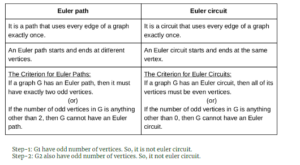 Incorrect
Incorrect

-
Question 29 of 30
29. Question
2 pointsWhat is the probability that a randomly selected bit string of length 10 is a palindrome?
Correct
“Palindrome is a number that remains the same when its digits are reversed.
Ex: 0, 1, 2, 3, 4, 5, 6, 7, 8, 9, 11, 22, 33, 44, 55, 66, 77, 88, 99, 101, 111, 121…,
Step-1: Here, string length is 10. If we consider first 5 numbers as random choices like 0 or 1.
Remaining 5 numbers are fixed. Total number of possibilities are 2 10 . But we are only considering first 5 choices. The probability is 2 5 .
Step-2: The probability 2 5 /2 10
= 1/2 5
= 1/32 “Incorrect
“Palindrome is a number that remains the same when its digits are reversed.
Ex: 0, 1, 2, 3, 4, 5, 6, 7, 8, 9, 11, 22, 33, 44, 55, 66, 77, 88, 99, 101, 111, 121…,
Step-1: Here, string length is 10. If we consider first 5 numbers as random choices like 0 or 1.
Remaining 5 numbers are fixed. Total number of possibilities are 2 10 . But we are only considering first 5 choices. The probability is 2 5 .
Step-2: The probability 2 5 /2 10
= 1/2 5
= 1/32 “ -
Question 30 of 30
30. Question
2 pointsLet A and B be sets in a finite universal set U. Given the following: |A – B|, |A ⊕ B|, |A| + |B| and |A ∪ B| Which of the following is in order of increasing size ?
Correct
Draw venn diagrams and you will find option 4 is the correct one
Incorrect
Draw venn diagrams and you will find option 4 is the correct one
- Next Quiz Daily at navclasses.in 12 PM
- Paper 2 Sunday at navclasses.in
Study Paper 1 Topics for Free Click Here
Get subscription for Complete Preparation NTA NET JRF: https://unacademy.com/subscribe/TEWDQ
use my referral code for 10% additional discount: NAVCLASSES
Search Navdeep Kaur and start watching ongoing courses
NTA NET Paper 1
Paper 2 CS Discrete Structures and Optimization Part 3
Quiz-summary
0 of 30 questions completed
Questions:
- 1
- 2
- 3
- 4
- 5
- 6
- 7
- 8
- 9
- 10
- 11
- 12
- 13
- 14
- 15
- 16
- 17
- 18
- 19
- 20
- 21
- 22
- 23
- 24
- 25
- 26
- 27
- 28
- 29
- 30
Information
Paper 1 Quiz helps u to Excel in NET JRF
Paper 1 All questions 2 Marks each
- Navdeep Kaur
- All the Best
You have already completed the quiz before. Hence you can not start it again.
Quiz is loading…
You must sign in or sign up to start the quiz.
You have to finish following quiz, to start this quiz:
Results
0 of 30 questions answered correctly
Your time:
Time has elapsed
You have reached 0 of 0 points, (0)
| Average score |
|
| Your score |
|
Categories
- Not categorized 0%
-
Average marks Improve next time All the Best
-
Nice Keep it up, Stay Blessed
-
Awesome Great Marks, Keep doing
| Pos. | Name | Entered on | Points | Result |
|---|---|---|---|---|
| Table is loading | ||||
| No data available | ||||
- 1
- 2
- 3
- 4
- 5
- 6
- 7
- 8
- 9
- 10
- 11
- 12
- 13
- 14
- 15
- 16
- 17
- 18
- 19
- 20
- 21
- 22
- 23
- 24
- 25
- 26
- 27
- 28
- 29
- 30
- Answered
- Review
-
Question 1 of 30
1. Question
2 points Correct
Correct
The transitive closure of R is obtained by repeatedly adding (a,c) to R for each (a,b) ∈ R and (b,c) ∈ R.
Incorrect
The transitive closure of R is obtained by repeatedly adding (a,c) to R for each (a,b) ∈ R and (b,c) ∈ R.
-
Question 2 of 30
2. Question
1 pointsLet A and B be two arbitrary events, then :
Correct
“Option-A is happens when A and B are independent.
Option-B is happens when A and B are mutually exclusive. P(A∪B) ≤ P(A) + P(B) is true because P(A∪B) = P(A) + P(B) – P(A∩B) “Incorrect
“Option-A is happens when A and B are independent.
Option-B is happens when A and B are mutually exclusive. P(A∪B) ≤ P(A) + P(B) is true because P(A∪B) = P(A) + P(B) – P(A∩B) “ -
Question 3 of 30
3. Question
2 pointsIf the proposition ¬ P → Q is true, then the truth value of the proportion ¬ PV (P → Q) is:
Correct
 Incorrect
Incorrect

-
Question 4 of 30
4. Question
2 pointsT is a graph with n vertices. T is connected and has exactly n-1 edges, then :
Correct
 Incorrect
Incorrect

-
Question 5 of 30
5. Question
2 points“The following lists are the degrees of all the vertices of a graph :
(i) 1, 2, 3, 4, 5
(ii) 3, 4, 5, 6, 7
(iii) 1, 4, 5, 8, 6
(iv) 3, 4, 5, 6
then “Correct
“Every graph is following basic 2 properties:
1. Sum of degrees of the vertices of a graph should be even.
2. Sum of degrees of the vertices of a graph is equal to twice the number of edges.
Statement-(i) is violating property-1.
= 1+2+3+4+5
= 15 is odd number.
Statement-(ii) is violating property-1.
= 3+4+5+6+7
= 25 is odd number.
Statement-(iii) is violating property-1.
= 1+4+5+8+6
= 24 is even number
Statement-(iv) is violating property-1
= 3+4+5+6
= 18 is even number “Incorrect
“Every graph is following basic 2 properties:
1. Sum of degrees of the vertices of a graph should be even.
2. Sum of degrees of the vertices of a graph is equal to twice the number of edges.
Statement-(i) is violating property-1.
= 1+2+3+4+5
= 15 is odd number.
Statement-(ii) is violating property-1.
= 3+4+5+6+7
= 25 is odd number.
Statement-(iii) is violating property-1.
= 1+4+5+8+6
= 24 is even number
Statement-(iv) is violating property-1
= 3+4+5+6
= 18 is even number “ -
Question 6 of 30
6. Question
2 pointsIf f(x) = x+1 and g(x)=x+3 then f0 f0 f0 f is :
Correct
“Given data,
f(x)=x+1
g(x)=x+3
Constraint is f0 f0 f0 f
Step-1: We can write into fo fo fo f is f(f(f(x+1)))
We can write into f(f(x+2)) and f(x+3).
Step-2: Above constraint is equal to “”x+4″” because f(x+3)+1
Step-3: We can also write into fog(x)=x+4 and gof(x)=x+4.
So, g+1 is appropriate answer. “Incorrect
“Given data,
f(x)=x+1
g(x)=x+3
Constraint is f0 f0 f0 f
Step-1: We can write into fo fo fo f is f(f(f(x+1)))
We can write into f(f(x+2)) and f(x+3).
Step-2: Above constraint is equal to “”x+4″” because f(x+3)+1
Step-3: We can also write into fog(x)=x+4 and gof(x)=x+4.
So, g+1 is appropriate answer. “ -
Question 7 of 30
7. Question
2 points“A v A=A is called :
Correct
List of theorems!
Incorrect
List of theorems!
-
Question 8 of 30
8. Question
2 points“Consider a proposition given as :
“ x ≥ 6, if x 2 ≥ 5 and its proof as:
If x ≥ 6, then x 2 = x.x ≥ 6.6 = 36 ≥ 25
Which of the following is correct w.r.to the given proposition and its proof?
(a)The proof shows the converse of what is to be proved.
(b)The proof starts by assuming what is to be shown.
(c)The proof is correct and there is nothing wrong. “Correct
The proof which is described in the question is wrong because for a given “x” value , x 2 >=5 but in the proof they mentioned 36>=25 which is wrong.
Incorrect
The proof which is described in the question is wrong because for a given “x” value , x 2 >=5 but in the proof they mentioned 36>=25 which is wrong.
-
Question 9 of 30
9. Question
2 points Correct
Correct
“→ In logic, contraposition is an inference that says that a conditional statement is logically equivalent to its contrapositive. The contrapositive of the statement has its antecedent and consequent inverted and flipped: the contrapositive of P → Q is thus as ~Q → ~P.
→ The equivalence relation translates verbally into “”if and only if”” and is symbolized by a double-lined, double arrow pointing to the left and right (↔). If A and B represent statements, then A ↔ B means “”A if and only if B.””
→ The exportation rule is a rule in logic which states that “”if (P and Q), then R”” is equivalent to “”if P then (if Q then R)””.
→ The exportation rule may be formally stated as: (P ∧ Q) → R is equivalent to P → (Q →R)
→ A mode of argumentation or a form of argument in which a proposition is disproven by following its implications logically to an absurd conclusion. Arguments that use universals such as, “always”, “never”, “everyone”, “nobody”, etc., are prone to being reduced to absurd conclusions. The fallacy is in the argument that could be reduced to absurdity — so in essence, reductio ad absurdum is a technique to expose the fallacy. “Incorrect
“→ In logic, contraposition is an inference that says that a conditional statement is logically equivalent to its contrapositive. The contrapositive of the statement has its antecedent and consequent inverted and flipped: the contrapositive of P → Q is thus as ~Q → ~P.
→ The equivalence relation translates verbally into “”if and only if”” and is symbolized by a double-lined, double arrow pointing to the left and right (↔). If A and B represent statements, then A ↔ B means “”A if and only if B.””
→ The exportation rule is a rule in logic which states that “”if (P and Q), then R”” is equivalent to “”if P then (if Q then R)””.
→ The exportation rule may be formally stated as: (P ∧ Q) → R is equivalent to P → (Q →R)
→ A mode of argumentation or a form of argument in which a proposition is disproven by following its implications logically to an absurd conclusion. Arguments that use universals such as, “always”, “never”, “everyone”, “nobody”, etc., are prone to being reduced to absurd conclusions. The fallacy is in the argument that could be reduced to absurdity — so in essence, reductio ad absurdum is a technique to expose the fallacy. “ -
Question 10 of 30
10. Question
2 points““If my computations are correct and I pay the electric bill, then I will run out of money. If I don’t pay the electric bill, the power will be turned off. Therefore, if I don’t run out of money and the power is still on, then my computations are incorrect.”
Convert this argument into logical notations using the variables c, b, r, p for propositions of computations, electric bills, out of money and the power respectively. (Where ¬ means NOT)”Correct
“We can represent ,
“c” for my computations are correct
“b” for I pay the electric bill.
“r” for I will run out of money
“p” for the power is on.
(c Λ b) means my computations are correct and I pay the electric bill.
(¬r Λ p) means I don’t run out of money and the power is still on.
According to the statement , the option -(A) is correct. “Incorrect
“We can represent ,
“c” for my computations are correct
“b” for I pay the electric bill.
“r” for I will run out of money
“p” for the power is on.
(c Λ b) means my computations are correct and I pay the electric bill.
(¬r Λ p) means I don’t run out of money and the power is still on.
According to the statement , the option -(A) is correct. “ -
Question 11 of 30
11. Question
2 points“Consider a Hamiltonian Graph (G) with no loops and parallel edges. Which of the following is true with respect to this Graph (G) ?
(a) deg (v) ≥ n / 2 for each vertex of G
(b) |E(G)| ≥ 1 / 2 (n – 1) (n – 2) + 2 edges
(c) deg (v) + deg (w) ≥ n for every n and v not connected by an edge. “Correct
“→ According to Dirac’s theorem on Hamiltonian cycles, the statement that an n-vertex graph in which each vertex has degree at least n/2 must have a Hamiltonian cycle.
→ According to ore’s theorem,Let G be a (finite and simple) graph with n ≥ 3 vertices. We denote by deg v the degree of a vertex v in G, i.e. the number of incident edges in G to v. Then, Ore’s theorem states that if deg v + deg w ≥ n for every pair of distinct non adjacent vertices v and w of G, then G is Hamiltonian.
→ A complete graph G of n vertices has n(n−1)/2 edges and a Hamiltonian cycle in G contains n edges. Therefore the number of edge-disjoint Hamiltonian cycles in G cannot exceed (n − 1)/2. When n is odd, we show there are (n − 1)/2 edge-disjoint Hamiltonian cycles.
So the statement(b) is false and statement a and c are true. “Incorrect
“→ According to Dirac’s theorem on Hamiltonian cycles, the statement that an n-vertex graph in which each vertex has degree at least n/2 must have a Hamiltonian cycle.
→ According to ore’s theorem,Let G be a (finite and simple) graph with n ≥ 3 vertices. We denote by deg v the degree of a vertex v in G, i.e. the number of incident edges in G to v. Then, Ore’s theorem states that if deg v + deg w ≥ n for every pair of distinct non adjacent vertices v and w of G, then G is Hamiltonian.
→ A complete graph G of n vertices has n(n−1)/2 edges and a Hamiltonian cycle in G contains n edges. Therefore the number of edge-disjoint Hamiltonian cycles in G cannot exceed (n − 1)/2. When n is odd, we show there are (n − 1)/2 edge-disjoint Hamiltonian cycles.
So the statement(b) is false and statement a and c are true. “ -
Question 12 of 30
12. Question
2 pointsIn how many ways can 15 indistinguishable fish be placed into 5 different ponds, so that each pond contains at least one fish ?
Correct
“→ We know that if we have “n” identical items which will be distributed in “r” distinct groups where each must get at least one then the number of way is C(n−1,r−1)
→ From the given question, n=15, r=5 We need to calculate C(14,4) and it’s value is 1001. “Incorrect
“→ We know that if we have “n” identical items which will be distributed in “r” distinct groups where each must get at least one then the number of way is C(n−1,r−1)
→ From the given question, n=15, r=5 We need to calculate C(14,4) and it’s value is 1001. “ -
Question 13 of 30
13. Question
2 pointsConsider an experiment of tossing two fair dice, one black and one red. What is the probability that the number on the black die divides the number on red die?
Correct
“→ From the given data, there are two dice and each dice the possible ways are 6. So total possible ways are 6*6=36 ways.
→ The possible ways are 1,2,3,4,5,6
→ The possible ways of one number divides another number are (1,1) (1,2), (1,3), (1,4), (1,5), (1,6), (2,2), (2,4), (2,6), (3,3), (3,6), (4,4), (5,5) and (6,6).
→ The probability is the number of outcomes / total outcomes = 14/36 “Incorrect
“→ From the given data, there are two dice and each dice the possible ways are 6. So total possible ways are 6*6=36 ways.
→ The possible ways are 1,2,3,4,5,6
→ The possible ways of one number divides another number are (1,1) (1,2), (1,3), (1,4), (1,5), (1,6), (2,2), (2,4), (2,6), (3,3), (3,6), (4,4), (5,5) and (6,6).
→ The probability is the number of outcomes / total outcomes = 14/36 “ -
Question 14 of 30
14. Question
2 pointsHow many strings of 5 digits have the property that the sum of their digits is 7?
Correct
“→ From the given question, there should be string with 5 digits and sum of that digits should be 7
→ There is no specification about positive,negative digits and also repetition of digits.
→ We are assuming the positive digits which is greater than or equal to 0.
→ The starting digit of the string should not be zero. We will also consider the repetition of digits.
→ Example of such strings are 70000,61000,60100,60010..,
→ The possible number of strings are C((n+r-1),(r-1))
→ From the given data n=7,r=5 then We have to fine C(11,4) which is equal to 330 “Incorrect
“→ From the given question, there should be string with 5 digits and sum of that digits should be 7
→ There is no specification about positive,negative digits and also repetition of digits.
→ We are assuming the positive digits which is greater than or equal to 0.
→ The starting digit of the string should not be zero. We will also consider the repetition of digits.
→ Example of such strings are 70000,61000,60100,60010..,
→ The possible number of strings are C((n+r-1),(r-1))
→ From the given data n=7,r=5 then We have to fine C(11,4) which is equal to 330 “ -
Question 15 of 30
15. Question
2 pointsHow many solutions are there for the equation x + y + z + u = 29 subject to the constraints that x ≥ 1, y ≥ 2, z ≥ 3 and u ≥ 0?
Correct
“Given data,
— The equation x+y+z+u = 29
— Constraints are x ≥ 1, y ≥ 2, z ≥ 3 and u ≥ 0
— Possible solutions?
Step-1: Combine all constraints (1+2+3+0) =6
Step-2: Subtract all constraints values with total equation number 29-6 =23.
Possibility to get repetition of a numbers of x,y and z but no chance for ‘u’ because its value is 0.
Step-3: So, Subtract repeated values into total equation value
= 29-3
= 26
Step-4: Possible solutions= 26 C 23
= 2600 “Incorrect
“Given data,
— The equation x+y+z+u = 29
— Constraints are x ≥ 1, y ≥ 2, z ≥ 3 and u ≥ 0
— Possible solutions?
Step-1: Combine all constraints (1+2+3+0) =6
Step-2: Subtract all constraints values with total equation number 29-6 =23.
Possibility to get repetition of a numbers of x,y and z but no chance for ‘u’ because its value is 0.
Step-3: So, Subtract repeated values into total equation value
= 29-3
= 26
Step-4: Possible solutions= 26 C 23
= 2600 “ -
Question 16 of 30
16. Question
2 points“Which of the following property/ies a Group G must hold, in order to be an Abelian group?
(a)The distributive property
(b)The commutative property
(c)The symmetric property “Correct
“An abelian group is a set, A, together with an operation • that combines any two elements a and b to form another element denoted a • b. The symbol • is a general placeholder for a concretely given operation. To qualify as an abelian group, the set and operation, (A, •), must satisfy five requirements known as the abelian group axioms:
Closure: For all a, b in A, the result of the operation a • b is also in A.
Associativity: For all a, b and c in A, the equation (a • b) • c = a • (b • c) holds.
Identity element: There exists an element e in A, such that for all elements a in A, the equation e • a = a • e = a holds.
Inverse element: For each a in A, there exists an element b in A such that a • b = b • a = e, where e is the identity element.
Commutativity: For all a, b in A, a • b = b • a.
A group in which the group operation is not commutative is called a “”non-abelian group”” or “”non-commutative group””. “Incorrect
“An abelian group is a set, A, together with an operation • that combines any two elements a and b to form another element denoted a • b. The symbol • is a general placeholder for a concretely given operation. To qualify as an abelian group, the set and operation, (A, •), must satisfy five requirements known as the abelian group axioms:
Closure: For all a, b in A, the result of the operation a • b is also in A.
Associativity: For all a, b and c in A, the equation (a • b) • c = a • (b • c) holds.
Identity element: There exists an element e in A, such that for all elements a in A, the equation e • a = a • e = a holds.
Inverse element: For each a in A, there exists an element b in A such that a • b = b • a = e, where e is the identity element.
Commutativity: For all a, b in A, a • b = b • a.
A group in which the group operation is not commutative is called a “”non-abelian group”” or “”non-commutative group””. “ -
Question 17 of 30
17. Question
2 points“Consider the compound propositions given below as:
(a)p ∨ ~(p ∧ q)
(b)(p ∧ ~q) ∨ ~(p ∧ q)
(c)p ∧ (q ∨ r)
Which of the above propositions are tautologies? “Correct
 Incorrect
Incorrect

-
Question 18 of 30
18. Question
2 points Correct
Correct
“→ Vacuous proof is a proof that the implication p → q is true based on the fact that p is false.
→ Trivial proof is a proof that the implication p → q is true based on the fact that q is true.
→ Direct proof is a proof that the implication p → q is true that proceeds by showing that q must be true when p is true.
→ Indirect proof is a proof that the implication p → q is true that proceeds by showing that p must be false when q is false. “Incorrect
“→ Vacuous proof is a proof that the implication p → q is true based on the fact that p is false.
→ Trivial proof is a proof that the implication p → q is true based on the fact that q is true.
→ Direct proof is a proof that the implication p → q is true that proceeds by showing that q must be true when p is true.
→ Indirect proof is a proof that the implication p → q is true that proceeds by showing that p must be false when q is false. “ -
Question 19 of 30
19. Question
2 points“Which of the following arguments are not valid ?
(a) “If Gora gets the job and works hard, then he will be promoted. If Gora gets promotion, then he will be happy. He will not be happy, therefore, either he will not get the job or he will not work hard”.
(b) “Either Puneet is not guilty or Pankaj is telling the truth. Pankaj is not telling the truth, therefore, Puneet is not guilty”.
(c) If n is a real number such that n >1, then n 2 >1. Suppose that n 2 >1, then n >1. “Correct
Validity using inferences
Incorrect
Validity using inferences
-
Question 20 of 30
20. Question
2 points Correct
Correct
 Incorrect
Incorrect

-
Question 21 of 30
21. Question
2 points“Which of the following is/are not true?
(a) The set of negative integers is countable.
(b) The set of integers that are multiples of 7 is countable.
(c)The set of even integers is countable.
(d)The set of real numbers between 0 and 1⁄2 is countable. “Correct
“(a)TRUE: The set of negative integers is countable.
Suppose negative integers set size is 10.
Ex: -1, -2, -3,…..,-10 is countable
(b)TRUE: The set of integers that are multiples of 7 is countable.
Suppose set of integers size is 10.
Ex: 1*7, 2*7, 3*7, …..,10*7 is countable
(c)TRUE: The set of even integers is countable.
Suppose set of even integers size is 10.
Ex: 2,4,6,8,10,….,20
(d) FALSE: The set of real numbers between 0 and 1⁄2 is countable. We can’t count real numbers.
Ex: 0.1, 0.2, 0.3, …..,0.∞ “Incorrect
“(a)TRUE: The set of negative integers is countable.
Suppose negative integers set size is 10.
Ex: -1, -2, -3,…..,-10 is countable
(b)TRUE: The set of integers that are multiples of 7 is countable.
Suppose set of integers size is 10.
Ex: 1*7, 2*7, 3*7, …..,10*7 is countable
(c)TRUE: The set of even integers is countable.
Suppose set of even integers size is 10.
Ex: 2,4,6,8,10,….,20
(d) FALSE: The set of real numbers between 0 and 1⁄2 is countable. We can’t count real numbers.
Ex: 0.1, 0.2, 0.3, …..,0.∞ “ -
Question 22 of 30
22. Question
2 points“Which of the following statement(s) is/are false ?
(a) A connected multigraph has an Euler Circuit if and only if each of its vertices has even degree.
(b) A connected multigraph has an Euler Path but not an Euler Circuit if and only if it has exactly two vertices of odd degree.
(c) A complete graph (K n ) has a Hamilton Circuit whenever n ≥ 3.
(d) A cycle over six vertices (C 6 ) is not a bipartite graph but a complete graph over 3 vertices is bipartite. “Correct
“(a)TRUE: A connected multigraph has an Euler Circuit if and only if each of its vertices has even degree.
(b)TRUE: A connected multigraph has an Euler Path but not an Euler Circuit if and only if it has exactly two vertices of odd degree.
(c)TRUE: A complete graph (K n ) has a Hamilton Circuit whenever n ≥ 3. (d) FALSE: A cycle over six vertices (C 6 ) is not a bipartite graph but a complete graph over 3 vertices is bipartite. “Incorrect
“(a)TRUE: A connected multigraph has an Euler Circuit if and only if each of its vertices has even degree.
(b)TRUE: A connected multigraph has an Euler Path but not an Euler Circuit if and only if it has exactly two vertices of odd degree.
(c)TRUE: A complete graph (K n ) has a Hamilton Circuit whenever n ≥ 3. (d) FALSE: A cycle over six vertices (C 6 ) is not a bipartite graph but a complete graph over 3 vertices is bipartite. “ -
Question 23 of 30
23. Question
2 points Correct
Correct
 Incorrect
Incorrect

-
Question 24 of 30
24. Question
2 pointsThere are three cards in a box. Both sides of one card are black, both sides of one card are red, and the third card has one black side and one red side. We pick a card at random and observe only one side. What is the probability that the opposite side is the same colour as the one side we observed?
Correct
“Given data,
— 3 cards in a box
— 1 st card: Both sides of one card is black. The card having 2 sides. We can write it as BB.
— 2 nd card: Both sides of one card is red. The card having 2 sides. We can write it as RR.
— 3rd card: one black side and one red side. We can write it as BR.
Step-1: The probability that the opposite side is the same colour as the one side we observed is 2⁄3 because total number of cards are 3 “Incorrect
“Given data,
— 3 cards in a box
— 1 st card: Both sides of one card is black. The card having 2 sides. We can write it as BB.
— 2 nd card: Both sides of one card is red. The card having 2 sides. We can write it as RR.
— 3rd card: one black side and one red side. We can write it as BR.
Step-1: The probability that the opposite side is the same colour as the one side we observed is 2⁄3 because total number of cards are 3 “ -
Question 25 of 30
25. Question
2 pointsSuppose that R 1 and R 2 are reflexive relations on a set A. Which of the following statements is correct ?
Correct
“A binary relation R over a set X is reflexive if every element of X is related to itself. Formally, this may be written ∀ x ∈X : xRx.
Ex: Let set A={0,1}
R 1 ={(0,0),(1,1)} all diagonal elements we are considering for reflexive relation.
R 2 ={(0,0),(1,1)} all diagonal elements we are considering for reflexive relation.
R 1 ∩ R 2 must have {(0,0),(1,1)} is reflexive.
R 1 ∪ R 2 must have {(0,0),(1,1)} is reflexive. “Incorrect
“A binary relation R over a set X is reflexive if every element of X is related to itself. Formally, this may be written ∀ x ∈X : xRx.
Ex: Let set A={0,1}
R 1 ={(0,0),(1,1)} all diagonal elements we are considering for reflexive relation.
R 2 ={(0,0),(1,1)} all diagonal elements we are considering for reflexive relation.
R 1 ∩ R 2 must have {(0,0),(1,1)} is reflexive.
R 1 ∪ R 2 must have {(0,0),(1,1)} is reflexive. “ -
Question 26 of 30
26. Question
2 pointsThe number of different spanning trees in complete graph, K 4 and bipartite graph, K 2,2 have ______ and _______ respectively.
Correct
“Step-1: Given complete graph K 4 .To find total number of spanning tree in complete graph using standard formula is n (n-2) Here, n=4
=n (n-2)
= 4 2
=16
Step-2: Given Bipartite graph K 2,2 . To find number of spanning tree in a bipartite graph K m,n having standard formula is m (n-1) * n (m-1) .
m=2 and n=2
= 2 (2-1) * 2 (2-1)
= 2 * 2
= 4 “Incorrect
“Step-1: Given complete graph K 4 .To find total number of spanning tree in complete graph using standard formula is n (n-2) Here, n=4
=n (n-2)
= 4 2
=16
Step-2: Given Bipartite graph K 2,2 . To find number of spanning tree in a bipartite graph K m,n having standard formula is m (n-1) * n (m-1) .
m=2 and n=2
= 2 (2-1) * 2 (2-1)
= 2 * 2
= 4 “ -
Question 27 of 30
27. Question
2 pointsHow many different equivalence relations with exactly three different equivalence classes are there on a set with five elements?
Correct
“Step-1: Given number of equivalence classes with 5 elements with three elements in each class will be 1,2,2 (or) 2,1,2 (or) 2,2,1 and 3,1,1.
Step-2: The number of combinations for three equivalence classes are
2,2,1 chosen in ( 5 C 2 * 3 C 2 * 1 C 1 )/2! = 15
3,1,1 chosen in( 5 C 2 * 3 C 2 * 1 C 1 )/2! = 10
Step-3: Total differential classes are 15+10
=25. “Incorrect
“Step-1: Given number of equivalence classes with 5 elements with three elements in each class will be 1,2,2 (or) 2,1,2 (or) 2,2,1 and 3,1,1.
Step-2: The number of combinations for three equivalence classes are
2,2,1 chosen in ( 5 C 2 * 3 C 2 * 1 C 1 )/2! = 15
3,1,1 chosen in( 5 C 2 * 3 C 2 * 1 C 1 )/2! = 10
Step-3: Total differential classes are 15+10
=25. “ -
Question 28 of 30
28. Question
2 points Correct
Correct
 Incorrect
Incorrect

-
Question 29 of 30
29. Question
2 pointsWhat is the probability that a randomly selected bit string of length 10 is a palindrome?
Correct
“Palindrome is a number that remains the same when its digits are reversed.
Ex: 0, 1, 2, 3, 4, 5, 6, 7, 8, 9, 11, 22, 33, 44, 55, 66, 77, 88, 99, 101, 111, 121…,
Step-1: Here, string length is 10. If we consider first 5 numbers as random choices like 0 or 1.
Remaining 5 numbers are fixed. Total number of possibilities are 2 10 . But we are only considering first 5 choices. The probability is 2 5 .
Step-2: The probability 2 5 /2 10
= 1/2 5
= 1/32 “Incorrect
“Palindrome is a number that remains the same when its digits are reversed.
Ex: 0, 1, 2, 3, 4, 5, 6, 7, 8, 9, 11, 22, 33, 44, 55, 66, 77, 88, 99, 101, 111, 121…,
Step-1: Here, string length is 10. If we consider first 5 numbers as random choices like 0 or 1.
Remaining 5 numbers are fixed. Total number of possibilities are 2 10 . But we are only considering first 5 choices. The probability is 2 5 .
Step-2: The probability 2 5 /2 10
= 1/2 5
= 1/32 “ -
Question 30 of 30
30. Question
2 pointsLet A and B be sets in a finite universal set U. Given the following: |A – B|, |A ⊕ B|, |A| + |B| and |A ∪ B| Which of the following is in order of increasing size ?
Correct
Draw venn diagrams and you will find option 4 is the correct one
Incorrect
Draw venn diagrams and you will find option 4 is the correct one






